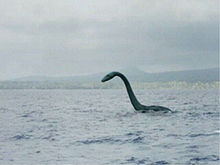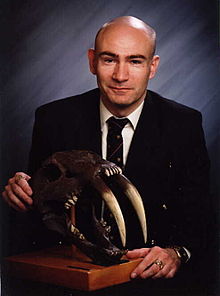- Cryptozoology
-
 Reconstruction of an alleged Ogopogo sighting
Reconstruction of an alleged Ogopogo sighting
Cryptozoology (from Greek κρυπτός, kryptos, "hidden" + zoology; literally, "study of hidden animals") refers to the search for animals whose existence has not been proven. This includes looking for living examples of animals that are considered extinct, such as dinosaurs; animals whose existence lacks physical evidence but which appear in myths, legends, or are reported, such as Bigfoot and Chupacabra;[1] and wild animals dramatically outside their normal geographic ranges, such as phantom cats or "ABCs" (an initialism commonly used by cryptozoologists that stands for Alien Big Cats).
The animals cryptozoologists study are often referred to as cryptids, a term coined by John Wall in 1983.[2]
Cryptozoology is not a recognized branch of zoology or a discipline of science.[1] It is an example of pseudoscience because it relies heavily upon anecdotal evidence, stories and alleged sightings.[3][4] [5]
Contents
Overview
The coining of the word cryptozoology is often attributed to Belgian-French zoologist Bernard Heuvelmans, though Heuvelmans attributes coinage of the term to the late Scottish explorer and adventurer Ivan T. Sanderson.[6] Heuvelmans' 1955 book On the Track of Unknown Animals traces the scholarly origins of the discipline to Anthonie Cornelis Oudemans and his 1892 study, The Great Sea Serpent.[7] Heuvelmans argued that cryptozoology should be undertaken with scientific rigor, but with an open-minded, interdisciplinary approach. He also stressed that attention should be given to local, urban and folkloric sources regarding such creatures, arguing that while often layered in unlikely and fantastic elements, folktales can have small grains of truth and important information regarding undiscovered organisms. Phantom cats (an example of living animals supposedly found outside of their normal range) are a common subject of cryptozoological interest,[8] largely due to the relative likelihood of existence in comparison to fantastical cryptids lacking any evidence of existence, such as Mothman.[9][10]
Another notable book on the subject is Willy Ley's Exotic Zoology (1959). Ley was best known for his writings on rocketry and related topics, but he was trained in paleontology, and wrote a number of books about animals. Ley's collection Exotic Zoology is of some interest to cryptozoology, as he discusses the Yeti and sea serpents, as well as relict dinosaurs. The book entertains the possibility that some legendary creatures (like the sirrush, the unicorn or the cyclops) might be based on actual animals, through misinterpretation of the animals and/or their remains. Also notable is the work of British zoologist and cryptozoologist Karl Shuker, who has published 12 books and countless articles on numerous cryptozoological subjects since the mid-1980s. Loren Coleman, a modern popularizer of cryptozoology, has chronicled the history and personalities of cryptozoology in his books.[11]
Discoveries
 An Okapi at Walt Disney's Animal Kingdom, symbol of the defunct International Society of Cryptozoology
An Okapi at Walt Disney's Animal Kingdom, symbol of the defunct International Society of Cryptozoology
Cryptozoologists claim there have been cases where species now accepted by the scientific community were initially considered superstition, hoaxes, delusions or misidentifications.[2] The popularly reported European discovery of the okapi in 1901, earlier hinted at but unseen by Henry Morton Stanley in his travelogue of exploring the Congo, later became the emblem for the now defunct International Society of Cryptozoology. The mountain gorilla,[12] giant squid[13] and Hoan Kiem Turtle[14][15] are other examples of extant species that were brought to the attention of modern science but formerly thought to be cryptids.
The 2003 discovery of the fossil remains of Homo floresiensis was cited by paleontologist Henry Gee, editor of the journal Nature as possible evidence that humanoid cryptids like the Orang Pendek and yeti were "founded on grains of truth". "Cryptozoology", Gee said, "the study of such fabulous creatures, can come in from the cold."[16]
Criticism
Cryptozoology has been criticised because of its reliance on anecdotal information[17] and because some cryptozoologists do not follow the scientific method[18][19] and devote a substantial portion of their efforts to investigations of animals that most scientists believe are unlikely to have existed.[20]
According to Mike Dash, a Welsh historian, few scientists doubt there are thousands of unknown animals, particularly invertebrates, awaiting discovery; however, cryptozoologists are largely uninterested in researching and cataloging newly-discovered species of ants or beetles, instead focusing their efforts towards "more elusive" creatures that have often defied decades of work aimed at confirming their existence.[20] The majority of mainstream criticism of cryptozoology is thus directed towards the search for megafauna cryptids such as Bigfoot, the Yeti, and the Loch Ness Monster, which appear often in popular culture, but for which there is little or no scientific support. Some scientists argue that megafauna cryptids are unlikely to exist undetected in great enough numbers to maintain a breeding population,[21] and are unlikely to be able to survive in their reported habitats due to issues of climate and food supply.[22]
See also
- Cryptobotany
- List of cryptids
- List of figures in cryptozoology
- Lazarus taxon
- Fortean Times Magazine
- Paranormal Magazine
References
- ^ a b Simpson, George G. (1984). "Mammals and Crytozoology". Proceedings of the American Philosophical Society (American Philosophical Society.) 128 (1): 1–19. JSTOR 986487.
- ^ a b Coleman, Loren and Clark, Jerome.Cryptozoology A to Z: The Encyclopedia of Loch Monsters, Sasquatch, Chupacabras, and Other Authentic Mysteries of Nature. New York: Fireside/Simon and Schuster, 1999
- ^ Carroll, Robert T. (1994-2009). "The Skeptic's Dictionary". http://www.skepdic.com/crypto.html. Retrieved 26 August 2010.
- ^ Shermer, Michael; Linse, Pat (2002). The Skeptic Encyclopedia of Pseudoscience. ABC-CLIO. ISBN 1576076539. http://books.google.com/?id=Gr4snwg7iaEC&pg=PA71&dq=The+Skeptic+Encyclopedia+of+Pseudoscience+cryptozoology&q.
- ^ H. James Birx (6 January 2009). Encyclopedia of time: science, philosophy, theology, & culture. SAGE. pp. 251–. ISBN 978-1-4129-4164-8. http://books.google.com/books?id=b3ddWSxmi9cC&pg=PA251. Retrieved 2 September 2011.
- ^ Heuvelmans, Bernard (1968). In the Wake of the Sea-Serpents. New York: Hill and Wang. ISBN 0809058146.
- ^ Bernard Heuvelmans (1965). On The Track Of Unknown Animals. New York: Hill and Wang. ISBN 0710304986.
- ^ Cryptozoology/Big Cats at the Open Directory Project
- ^ "Big Cat evidence gets stronger, as society calls for government study". British Big Cats Society. http://www.britishbigcats.org/news.php. Retrieved 2010-02-09.
- ^ Brad Fear (2008). A Macabre Myth of a Moth-Man. ISBN 1438902646.
- ^ Loren Coleman (2002). Tom Slick: True Life Encounters in Cryptozoology. Fresno, California: Craven Street Books/Linden Press. ISBN 0941936740.
- ^ Krystek, Lee. "A Gallery of Cryptozoological Alumni". The Museum of UnNatural Mystery. The UnMuseum. http://www.unmuseum.org/found.htm. Retrieved 20 December 2010.
- ^ Countdowns, LiveScience. "Rumor or Reality: The Creatures of Cryptozoology". Imaginova. LiveScience. http://www.livescience.com/animals/top10_creatures_of_cryptozoology-1.html. Retrieved 20 December 2010.
- ^ Coleman, Loren; Patrick Huyghe (2003). The Field Guide to Lake Monsters, Sea Serpents, and other mystery denizens of the deep. Penguin Books. ISBN 1-58542-252-5.
- ^ News Service, Vietnam (May 28, 2006). "The legend of the Hoan Kiem Turtle". Asian Turtle Conservation Network. http://www.asianturtlenetwork.org/library/news_articles/The_legend_of_the_Hoan_Kiem_Turtle.html. Retrieved 20 December 2010.
- ^ Henry Gee (2004). "Flores, God and Cryptozoology: The discovery poses thorny questions about the uniqueness of Homo sapiens". Nature. http://www.bioedonline.org/news/news.cfm?art=1329.
- ^ Shermer, Michael (2003). "Show Me the Body". Scientific American (288(5)): 27. http://www.michaelshermer.com/2003/05/show-me-the-body.
- ^ Coleman, Loren; Huyghe, Patrick (April 1999). "Afterword". The Field Guide to Bigfoot, Yeti, and Other Mystery Primates Worldwide. Trumbore, Harry. New York, New York: Avon Books. pp. 207. ISBN 0-380-80263-5.
- ^ Coleman, Loren; Huyghe, Patrick; Trumbore, Harry; Rollins, Mark Lee (2003). The Field Guide to Lake Monsters, Sea Serpents, and Other Mystery Denizens of the Deep. New York, New York: Penguin Group. pp. 358. ISBN 1-58542-252-5.
- ^ a b Dash, Mike (2000). Borderlands: The Ultimate Exploration of the Unknown. Overlook Press. ISBN 0440236568.
- ^ "Bigfoot hunting". http://home.clara.net/rfthomas/news/bfhunting.html. Retrieved December 2010.
- ^ Sjögren, Bengt (1980). Berömda vidunder. Settern. ISBN 91-7586-023-6. (Swedish)
Further reading
- Arment, Chad. Cryptozoology: Science & Speculation. Landisville, Penn.: Coachwhip, 2004, ISBN 1-930585-15-2.
- Arnold, Neil. MONSTER! The A-Z Of Zooform Phenomena. Bideford: CFZ Press, 2007, ISBN 1905723172.
- Budd, Deena. The Weiser Field Guide to Cryptozoology . Redwheel, Weiser, 2010, ISBN 978-1-57863-450-7.
- Coghlan, Ronan. Dictionary of Cryptozoology. Bangor: Xiphos, 2004.
- Eberhart, George M. (2002). Mysterious Creatures: A Guide to Cryptozoology. 2. Santa Barbara, California: ABC-CLIO. pp. 722. ISBN 1-57607-283-5 accessdate=December 7, 2010. http://www.ebook3000.com/animals/Mysterious-Creatures--A-Guide-to-Cryptozoology_64383.html. and at Google Books.
- Ley, Willy. Exotic Zoology ISBN 0517625458.
- North American BioFortean Review, Index to issues.
- Shuker, Karl. The Beasts That Hide From Man: Seeking the World's Last Undiscovered Animals. New York: Paraview Press, 2003, ISBN 1931044613.
External links
Categories:- Cryptids
- Cryptozoology
Wikimedia Foundation. 2010.

